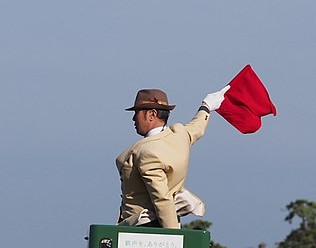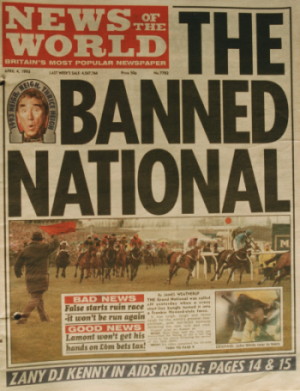 The 1993 Grand National, the race that never was. A wild day at Aintree, strange in every way, saw a race run, but one that was declared void for the only time in the race’s history. Many will remember this day, it wasn’t the best day for racing, but it did bring about many changes in the sport, which have since had a positive impact.
The 1993 Grand National, the race that never was. A wild day at Aintree, strange in every way, saw a race run, but one that was declared void for the only time in the race’s history. Many will remember this day, it wasn’t the best day for racing, but it did bring about many changes in the sport, which have since had a positive impact.
The ‘winner’ of the contest was Esha Ness, trained by Jenny Pitman and ridden by John White. Had the result stayed official, it would have been a first win in the race for White and a second victory for Pitman, who had become the first female to train a Grand National winner back in 1983.
A wild day, one that would have gone under the radar had it happened at a regular meeting during the week, but a story that took the world by storm because of the race involved. As ever with the Grand National, it amplifies things, and this was a prime example of that.
Results
| Result | Horse | Starting Price | Age | Handicap | Prize Money | Jockey | Trainer |
|---|---|---|---|---|---|---|---|
| 1 | Esha Ness | 50/1 | 10 | 10-00 | £102,495 | John White | Jenny Pitman |
| 2 | Cahervillahow | 25/1 | 9 | 10-11 | - | Charlie Swan | Michael “Mouse” Morris |
| 3 | Romany King | 15/2 | 9 | 10-7 | - | Adrian Maguire | G B ‘Toby’ Balding |
| 4 | The Committee | 25/1 | 10 | 10-00 | - | Norman Williamson | J H Scott |
| 5 | Givus A Buck | 16/1 | 10 | 10-00 | - | Paul Holley | David Raymond Cecil Elsworth |
| 6 | On The Other Hand | 20/1 | 10 | 10-3 | - | Neale Doughty | Gordon W Richards |
| 7 | Laura's Beau | 20/1 | 9 | 10-00 | - | Conor O’Dwyer | Francis Berry |
Non Finishers
What Happened In The 1993 Grand National?
There is the full story of the 1993 Grand National and also a simple short story. Let’s go with the latter first. The race had a false start, which was flagged down, and the runners returned to the start line. Then the race had a second false start, which wasn’t flagged down properly, and for this reason, many taking part didn’t know they had to stop, so the race took place.
The race kept going right until the end, with Esha Ness crossing the line in first place, Cahervillahow came second, and Romany King finished third. Seven runners completed the whole course and crossed the line, the others either did not start, stopped when they realised it was a false start or fell while running in the race.
Onto the bigger details now, as to what actually happened on the day. First of all, let’s look at the first false start in the race, the one that was flagged up. This was caused by the starting tape being wrapped up around a handful of riders. Starter Keith Brown flagged this down straight away, this was seen and flagged down elsewhere by others, and the riders all saw this and promptly stopped.
This led to a short delay while everyone returned to the starting point, where a second start would take place. It was at this moment where things began to go badly. The starting tape was again at fault, but this time affecting just one jockey, which was Richard Dunwoody. The starter let them go, but when Dunwoody complained, the starter was unable to wave his flag properly and struggled to get the attention of others.
With just one rider involved, very few amongst the jockeys realised what was going off, which is understandable when you are in the middle of the start at the greatest race and want to get off to a good one.
Further down the track, there was nothing seen about the false start due to the starter not being able to get the message out, so the person who stopped them the first time didn’t stop them the second time around. 30 of the 39 riders set off and jumped the first.
They went around the first circuit losing just one faller, and despite the crowd and people around the track trying to stop the race, no one could get a clear message to the jockeys. It was at the water jump, the final jump of the first circuit, where some jockeys began to realise what was going off and pulled up their mounts, including many of the fancied runners and those struggling at the back.
However, 14 remained racing as the second circuit began, so there was still a big field going around Aintree. These jockeys later spoke and said they believed the calls to stop from the side of the track were coming from protestors who had managed to get into the track in a bid to stop the race.
In the end, seven horses fully completed the course, with the commentary explaining during the race that this would be void, and all in all, the situation was a bit of a mess for racing and certainly didn’t put the sport in a good light.
After the race, as you can imagine, this was not over, and there was a lot of talk about what happened, why it happened, and what would be done in the future to prevent anything like that from ever happening again.
New Starting Procedures Agreed After The Race

One long-term change to racing was new starting procedures that would come into play for all racing a year later. After the contest had tarnished the sport, an enquiry into what happened was held at the High Court, chaired by Sir Michael Connell, who had been deputy senior steward of the Jockey Club since 1988.
The blame was mainly put onto two people. Some was attached to starter Keith Brown, who failed on both starts for allowing the horses to get too close to the tape, which then caused this to get wrapped around various jockeys.
Most of the blame was put on Ken Evans, though, the steward who was further down the track. He failed to notice the second false start, in part due to a flag malfunction, but had he seen this, he would have been in a position to stop everyone at the start, at a time when another restart could have been done.
The moment Evans didn’t stop the race, horses had been going for too long to have another start, it wouldn’t have been a level playing field for them to compete off.
On the back of this enquiry, a 34-page document was produced detailing the issues and highlighting areas where improvement and rule changes could be made. This didn’t recommend technology, such as horns, sirens, flashing lights and other things, which were found to not work very well overseas.
Confusion In The Aftermath Paints Racing In A Bad Light
There was a lot of confusion in the aftermath, which certainly didn’t help the image of racing. It was said at the time that 7,000 races were ran in 1993, and the false start procedure failed to work on just three occasions. However, because one of them was the Grand National, a race that everyone watches, a huge deal was made of it.
Confusion was made worse after the race when the starter Keith Brown was interviewed live on BBC. He said that the nine jockeys who obeyed the rules and didn’t set off would be eligible to take part in a re-run, with just nine horses involved.
Jockeys who remained in the race painted a picture of much confusion when asked afterwards. Stories from assuming the people shouting were protestors to wanting to stop but being scared of the consequences because others were remaining in the race were very commonly spoken about.
In the end, the Jockey Club officially declared the race void. There would not be a re-run, and all bets on the contest would be returned. It is estimated that bookmakers had to give back around £75 million to punters who had placed bets on the race on what is traditionally their biggest day of the year.
Moments Of Note
- The 1993 race will forever be known as the race that never was. Everyone watching, other than those who completed the race, knew it would not count, leading to a bizarre few moments for the sport.
- Starter Keith Brown and steward Ken Evans were blamed for the outcome of the race in the enquiry that took place afterwards, with most of the blame going on Evans.
- In what should be a big, profitable day, bookmakers had to return £75 million in void bets.
- Esha Ness was the ‘winner’ of the race, from those that continued.

